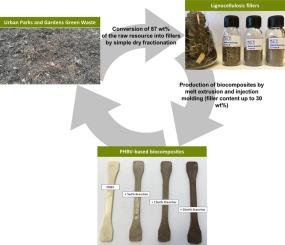Waste Management ( IF 8.1 ) Pub Date : 2020-10-29 , DOI: 10.1016/j.wasman.2020.10.018 Amandine Viretto , Nathalie Gontard , Hélène Angellier-Coussy

|
Urban parks and gardens green waste constitute a low-cost and highly available lignocellulosic-rich resource, that is currently treated in composting or anaerobic digestion processes. The present work investigated for the first time the potential of using urban green waste as raw resource for the production of lignocellulosic fillers by dry fractionation (combination of sorting and grinding processes). Five fractions of lignocellulosic fillers with controlled composition were produced: a branches-rich fraction, a grasses-rich fraction, a leaves-rich fraction, and two fractions constituted of a mixture of constituents. All the fractions were ground to reach an average median diameter around 100 μm. The reinforcing effect of each fraction was investigated and compared to that of the sample as a whole. Biocomposites based on a poly(3-hydroxybutyrate-co-3-hydroxyvalerate) as matrix were produced by melt extrusion, with filler contents up to 30 wt%. It was shown that the branches-rich fraction displayed the best reinforcing effect (e.g. stress at break of 37 ± 1 MPa for a filler content of 15 wt%, similar to that of the neat matrix) whereas the grasses-rich fraction slightly degraded the overall mechanical performance (e.g. stress at break of 33.5 ± 1.5 MPa for a filler content of 15 wt%). The dry fractionation and formulation steps could be thus adapted depending on the targeted application, e.g. by choosing to use the whole urban green waste resource, or to remove grasses, or to keep only branches.
中文翻译:

城市公园和花园的绿色废物:生产生物复合材料填料的宝贵资源
城市公园和花园中的绿色废物构成了一种低成本且高度可用的富含木质纤维素的资源,目前正在堆肥或厌氧消化过程中对其进行处理。本工作首次调查了利用城市绿色废物作为原料通过干法分馏(分选和研磨过程的组合)生产木质纤维素填料的潜力。产生了五个具有受控组成的木质纤维素填料馏分:富含树枝的馏分,富含草的馏分,富含叶子的馏分和由组分混合物组成的两个馏分。将所有级分研磨以达到约100μm的平均中值直径。研究每个部分的增强效果,并将其与整个样品的增强效果进行比较。通过熔融挤出制备基于聚(3-羟基丁酸酯-co-3-羟基戊酸酯)作为基质的生物复合材料,其中填料含量最高为30wt%。结果表明,富含树枝的部分表现出最佳的增强效果(例如,填料含量为15 wt%时,断裂应力为37±1 MPa,与纯基质的情况相似),而富含草的部分则略有降解。总体机械性能(例如,填充剂含量为15 wt%时,断裂应力为33.5±1.5 MPa)。因此,可以根据目标应用来调整干法分馏和配制步骤,例如,通过选择使用全部城市绿色废物资源,或清除草,或仅保留树枝。结果表明,富含树枝的部分表现出最佳的增强效果(例如,填料含量为15 wt%时,断裂应力为37±1 MPa,与纯基质的情况相似),而富含草的部分则略有降解。总体机械性能(例如,填充剂含量为15 wt%时,断裂应力为33.5±1.5 MPa)。因此,可以根据目标应用来调整干法分馏和配制步骤,例如,通过选择使用全部城市绿色废物资源,或清除草,或仅保留树枝。结果表明,富含树枝的部分表现出最佳的增强效果(例如,填料含量为15 wt%时,断裂应力为37±1 MPa,与纯基质的情况相似),而富含草的部分则略有降解。总体机械性能(例如,填充剂含量为15 wt%时,断裂应力为33.5±1.5 MPa)。因此,可以根据目标应用来调整干法分馏和配制步骤,例如,通过选择使用全部城市绿色废物资源,或清除草,或仅保留树枝。


























 京公网安备 11010802027423号
京公网安备 11010802027423号